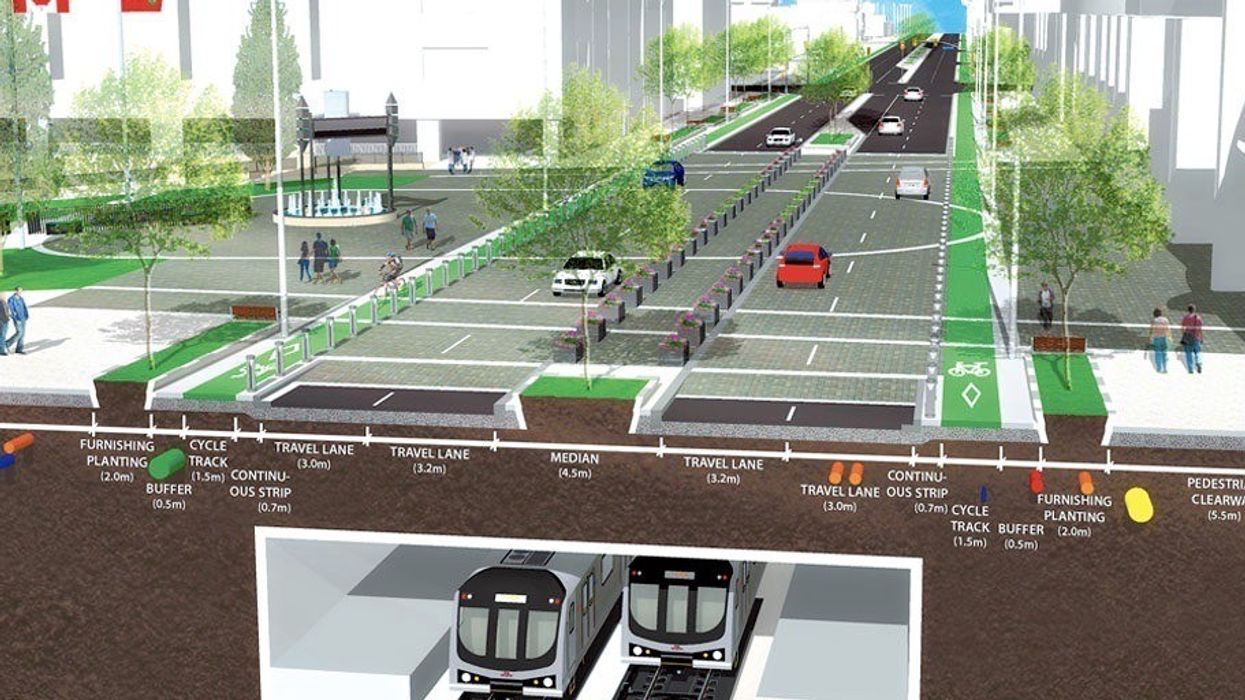It may be a city in a rush, but still Toronto can’t keep up with itself.
Our reluctance to revitalize Yonge Street between Sheppard and Finch is a telling example. When it was remade as a six-lane highway decades ago, the car was king and North York was a concrete suburb most commuters drove through not to. Since then the former City With Heart, or at least this stretch of it, has become a densely populated neighbourhood with tens of thousands of residents.
READ: Why This North York Neighbourhood is One of the City’s Hottest Spots to Live
Unsurprisingly, they want Yonge returned to what it once was -- a main street, their main street. A plan to accomplish this has been circulating since 2014. And although locals like what they see, city council has given it a rough ride. In 2017, the scheme was rejected -- even Mayor John Tory voted against it. But this week, the report, REimagine Yonge, finally made it through committee and will go before full council again later this month.
The plan would narrow Yonge from six lanes to four while widening sidewalks, adding benches and rows of trees while providing separated space for bikes. The idea, of course, is to create conditions that will encourage walking and a richer street life.
Who could disagree with such civilized intentions?
Veteran Willowdale Councillor John Filion isn’t holding his breath. “I think it will pass at council in two weeks,” he says. “But doesn’t mean it will happen. It’s a matter of a fair bit of time and a fair bit of money. It depends on the next mayor.”
Filion, who has championed the plan for years, is up against council’s designated dinosaurs, Denzil Minnan-Wong, Stephen Holyday, Mike Ford…. Even Councillor James Pasternak, who chairs the city’s Infrastructure and Environment Committee, decided at Tuesday’s meeting to insert a last-minute motion that would have required municipal staff to rewrite the proposal.
That was defeated by the committee’s more progressive members, but Pasternak’s tactic was a nasty reminder of the extent to which official Toronto remains committed to the car. Indeed, committee member Minnan-Wong pointedly questioning one speaker – Gideon Foreman of the Suzuki Foundation -- about an opinion poll finding that 84% of Torontonians support the plan. Minnan-Wong worried the changes would “create congestion” and compromise the city’s prosperity.
But as Councillor Mike Layton, who also sits on the committee, noted: “It’s really easy to be afraid of change. The easiest thing to do in this job is nothing.”
In fact, the overwhelming majority of speakers supported the plan. As several of them made clear, fully 75% of the traffic along this stretch of Yonge originates in the 905. The street was designed as an on- and off-ramp for Highway 401. Rush hour line-ups extend for blocks. The consequences have been dire; according to official figures, since 2011 there have been 159 collisions involving pedestrians and cyclists, ten of them fatal.
Filion is shocked but not surprised: “What other six-lane highway can you name that has so many pedestrians alongside it?” he asks.
Ironically, perhaps, an unexpected result of Covid-19 has been a massive increase in awareness of the need to reclaim the street from the car not just here but around the world. Toronto has not been in the forefront of this powerful wave of urbanism sweeping the globe, yet even in the 416 major roads have been handed over to restaurants and cafes. Others have been closed to cars in favour of walkers and cyclists. These measures, though temporary, have transformed how Torontonians inhabit the city. From King and Queen to Danforth and Bayview and, yes, Yonge, people have made city streets their own. They have turned them from simple transit corridors into complex destinations. In so doing, they have laid the foundation for a more nuanced and ambitious understanding of urbanism.
READ: Is It Time to Close Toronto’s Streets to Cars?
Perhaps the most radical aspect of the scheme is what it could mean for the rest of suburbia. How will local politicians respond when voters start to demand more complete communities, places where they and their kids don’t have to live in the shadow of the car?
It will take a new generation of civic leadership to implement fully the principles that inform REimagine Yonge, but they will come. And to be fair, not all council members are as embarrassingly regressive as Minnan-Wong, Holyday, et al. Filion’s project suggests what Toronto could be -- and most of us like what we see.
Now we want more.


















